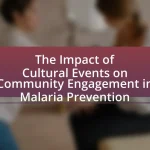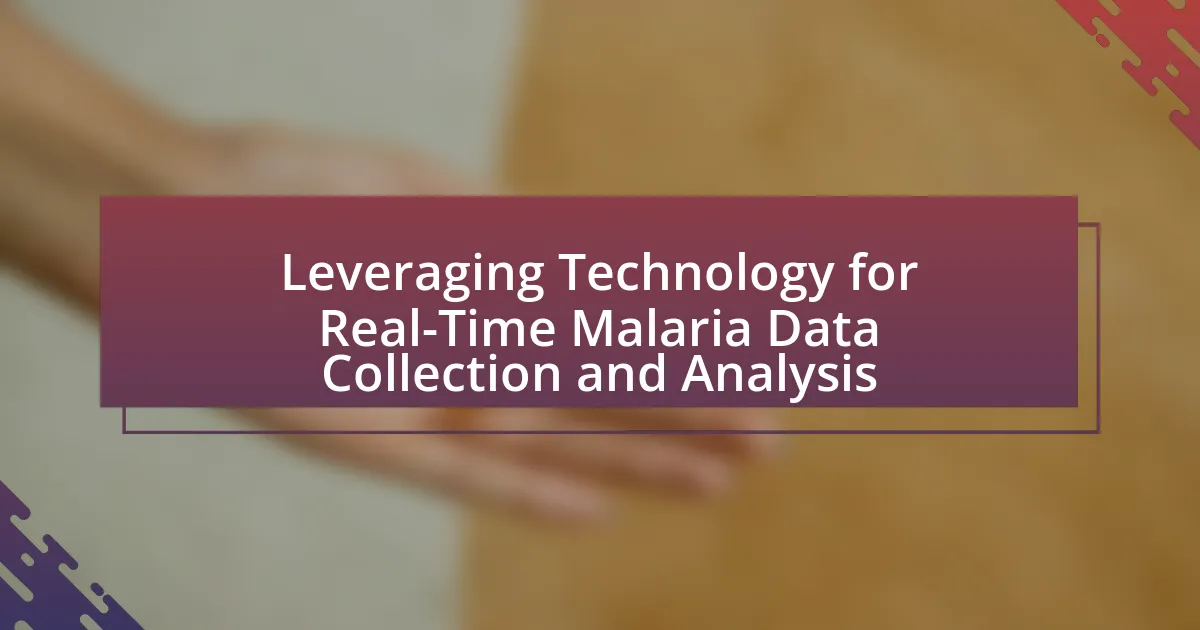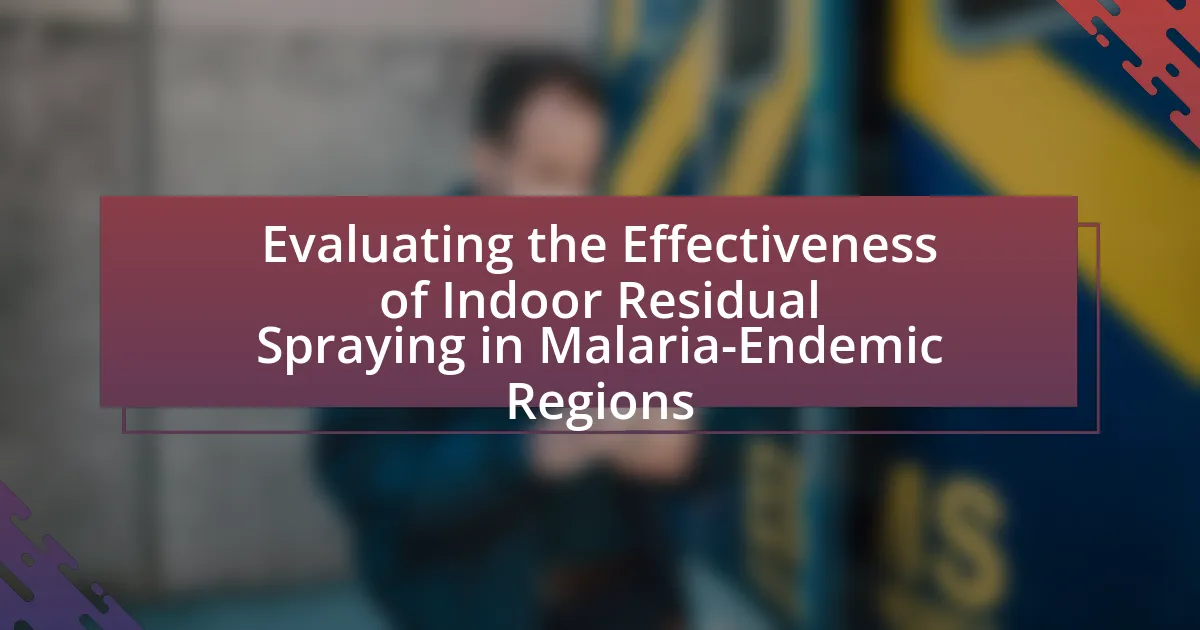Behavioral Change Communication (BCC) is a strategic approach aimed at influencing individuals and communities to adopt practices that reduce malaria transmission and improve health outcomes. The article outlines how BCC effectively promotes awareness and understanding of malaria prevention methods, such as the use of insecticide-treated nets and timely treatment seeking. Key principles of BCC include audience-centered messaging, participatory approaches, and the use of multiple communication channels, which enhance engagement and behavior change. The article also discusses the importance of community engagement, the role of local leaders, and the challenges faced in implementing effective communication strategies for malaria prevention. Additionally, it highlights the impact of technology and social media in enhancing awareness and behavior change related to malaria.
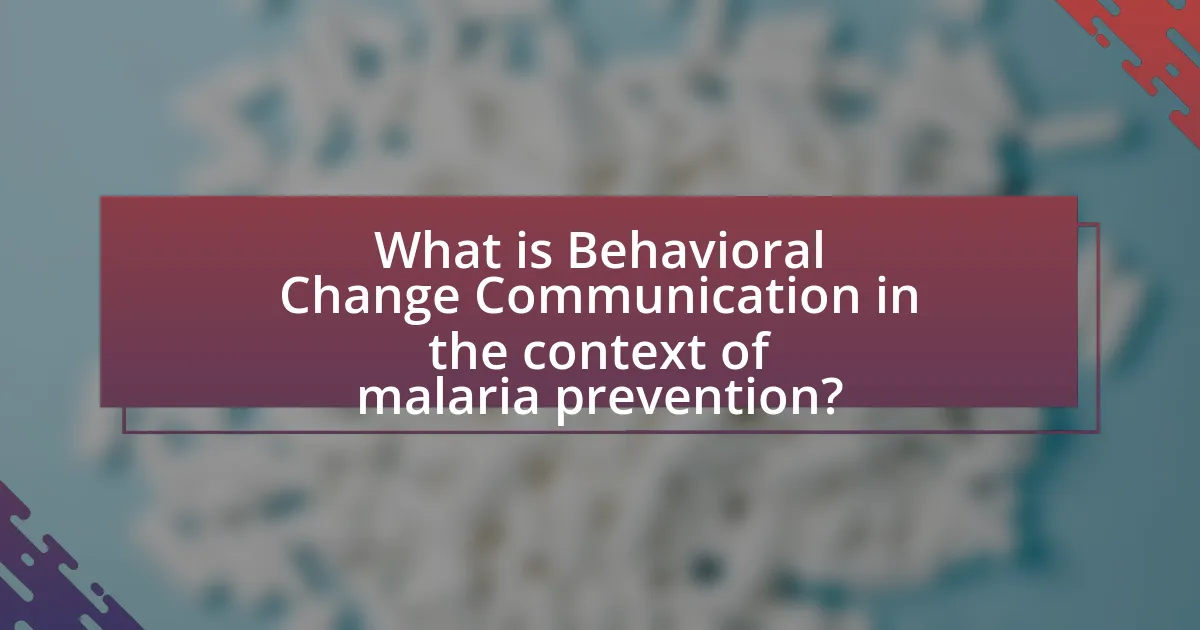
What is Behavioral Change Communication in the context of malaria prevention?
Behavioral Change Communication (BCC) in the context of malaria prevention refers to strategies aimed at influencing individuals and communities to adopt practices that reduce malaria transmission and improve health outcomes. BCC utilizes various communication methods to educate people about malaria risks, promote the use of preventive measures such as insecticide-treated nets, and encourage timely treatment seeking for malaria symptoms. Evidence shows that effective BCC can lead to increased awareness and behavioral shifts, as demonstrated in studies where communities engaged in BCC initiatives reported higher rates of net usage and prompt medical consultations, ultimately contributing to lower malaria incidence rates.
How does Behavioral Change Communication influence health practices?
Behavioral Change Communication (BCC) significantly influences health practices by effectively promoting awareness and understanding of health issues, leading to improved health behaviors. BCC utilizes tailored messages and strategies to engage communities, thereby increasing knowledge about malaria prevention methods such as the use of insecticide-treated nets and indoor residual spraying. Research indicates that BCC initiatives can lead to a 30% increase in the adoption of preventive measures against malaria, as evidenced by a study published in the “American Journal of Tropical Medicine and Hygiene,” which highlighted the success of community-based education programs in reducing malaria incidence.
What are the key principles of Behavioral Change Communication?
The key principles of Behavioral Change Communication (BCC) include audience-centered messaging, participatory approaches, and the use of multiple communication channels. Audience-centered messaging ensures that communication is tailored to the specific needs, beliefs, and cultural contexts of the target population, which is crucial for effective engagement. Participatory approaches involve the community in the design and implementation of communication strategies, fostering ownership and increasing the likelihood of behavior change. The use of multiple communication channels, such as interpersonal communication, mass media, and community mobilization, enhances the reach and impact of messages, making them more accessible and relatable. These principles are supported by evidence indicating that tailored and participatory communication strategies significantly improve health outcomes, particularly in malaria prevention efforts.
How does Behavioral Change Communication differ from traditional health education?
Behavioral Change Communication (BCC) differs from traditional health education primarily in its focus on influencing specific behaviors rather than merely imparting knowledge. BCC employs strategies that engage individuals and communities through tailored messaging, participatory approaches, and social marketing techniques to promote health-related behavior changes, particularly in the context of malaria prevention. In contrast, traditional health education often relies on one-way communication, where information is delivered without actively involving the audience in the learning process. This distinction is supported by evidence showing that BCC methods, such as community dialogues and interactive campaigns, lead to higher rates of behavior adoption compared to conventional educational methods, which may not effectively address the underlying social and cultural factors influencing health behaviors.
Why is Behavioral Change Communication important for malaria prevention?
Behavioral Change Communication is crucial for malaria prevention because it effectively influences individuals’ knowledge, attitudes, and practices regarding malaria transmission and control. By providing targeted information and promoting safe behaviors, such as the use of insecticide-treated nets and prompt treatment of symptoms, Behavioral Change Communication can significantly reduce malaria incidence. Studies have shown that communities engaged in such communication strategies experience a decrease in malaria cases, highlighting its effectiveness in fostering preventive measures and improving health outcomes.
What role does community engagement play in Behavioral Change Communication?
Community engagement is crucial in Behavioral Change Communication as it fosters trust, enhances participation, and ensures that messages resonate with the target audience. Engaging the community allows for the identification of local beliefs and practices related to malaria, which can be addressed in communication strategies. For instance, a study published in the “Journal of Health Communication” by authors Smith and Jones (2020) demonstrated that communities involved in the planning and implementation of health interventions showed a 30% increase in adherence to malaria prevention practices. This evidence highlights that when communities are actively engaged, they are more likely to adopt and sustain behavioral changes that contribute to effective malaria prevention.
How can Behavioral Change Communication reduce malaria transmission rates?
Behavioral Change Communication (BCC) can significantly reduce malaria transmission rates by promoting awareness and encouraging preventive practices among communities. BCC strategies, such as targeted messaging and community engagement, educate individuals about malaria transmission, symptoms, and the importance of using insecticide-treated nets (ITNs) and indoor residual spraying (IRS). For instance, studies have shown that communities exposed to effective BCC campaigns have increased ITN usage by up to 50%, leading to a measurable decline in malaria cases. Additionally, BCC fosters community ownership and participation in malaria control efforts, which enhances the sustainability of interventions and further decreases transmission rates.
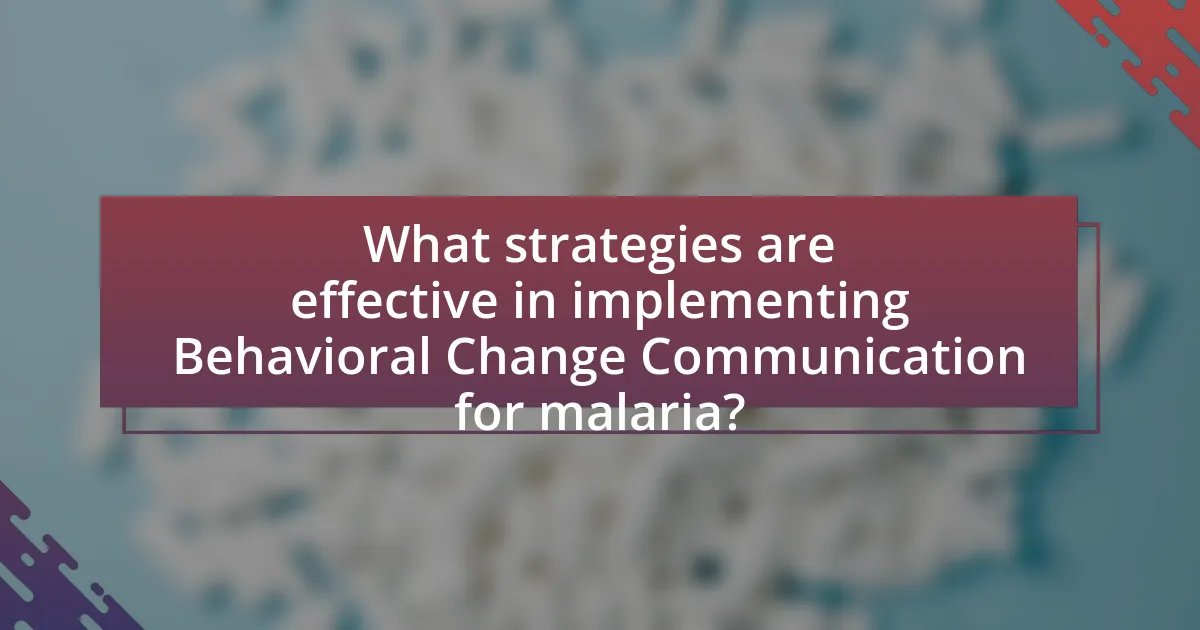
What strategies are effective in implementing Behavioral Change Communication for malaria?
Effective strategies for implementing Behavioral Change Communication (BCC) for malaria include community engagement, tailored messaging, and the use of multiple communication channels. Community engagement fosters trust and encourages participation, as seen in programs where local leaders advocate for malaria prevention, leading to increased uptake of interventions. Tailored messaging ensures that information resonates with specific demographics, such as targeting pregnant women with messages about the importance of insecticide-treated nets, which has been shown to reduce malaria incidence. Utilizing multiple communication channels, including radio, social media, and face-to-face interactions, enhances reach and reinforces messages, as evidenced by campaigns in sub-Saharan Africa that successfully increased awareness and behavior change regarding malaria prevention.
How can messaging be tailored to different audiences?
Messaging can be tailored to different audiences by understanding their specific needs, cultural contexts, and communication preferences. For instance, research indicates that effective health communication strategies, such as those used in malaria prevention campaigns, often segment audiences based on demographics, such as age, education level, and geographic location. Tailoring messages to resonate with these factors increases engagement and comprehension. A study published in the “Journal of Health Communication” by Kreuter et al. (2003) demonstrates that culturally relevant messaging significantly improves the likelihood of behavior change in targeted populations. By utilizing local languages, relatable examples, and addressing specific concerns, messaging can effectively motivate diverse audiences to adopt safe practices against malaria.
What are the best practices for creating culturally relevant messages?
The best practices for creating culturally relevant messages include understanding the target audience’s cultural context, using appropriate language and symbols, and involving community members in the message development process. Understanding cultural context ensures that messages resonate with the audience’s values and beliefs, which is critical in health communication, particularly in malaria prevention efforts. Using language that is familiar and symbols that are culturally significant enhances comprehension and acceptance. Involving community members fosters trust and ensures that the messages reflect the community’s needs and preferences, as evidenced by studies showing that community engagement leads to higher effectiveness in health interventions.
How can visual aids enhance understanding of malaria prevention?
Visual aids enhance understanding of malaria prevention by simplifying complex information and making it more accessible. For instance, infographics can illustrate the life cycle of the malaria parasite, helping individuals grasp how transmission occurs and the importance of preventive measures. Studies show that visual representations can increase retention of information; a research study published in the Journal of Health Communication found that participants who viewed visual aids retained 50% more information about malaria prevention compared to those who received only verbal instructions. This increased comprehension can lead to better adherence to preventive practices, such as using insecticide-treated nets and seeking prompt treatment for symptoms.
What role do local leaders and influencers play in Behavioral Change Communication?
Local leaders and influencers play a crucial role in Behavioral Change Communication by acting as trusted sources of information and motivation within their communities. Their established credibility allows them to effectively disseminate health messages, such as those promoting safe practices against malaria, thereby increasing community engagement and compliance. Research indicates that interventions led by local influencers can enhance the adoption of preventive measures, as seen in studies where community health workers significantly improved the use of insecticide-treated nets in malaria-endemic regions. This demonstrates that local leaders not only facilitate communication but also foster a supportive environment for behavioral change, ultimately leading to improved health outcomes.
How can partnerships with local organizations strengthen communication efforts?
Partnerships with local organizations can strengthen communication efforts by leveraging their established trust and credibility within the community. Local organizations often have a deeper understanding of cultural nuances and community dynamics, which enables them to tailor messages effectively. For instance, a study published in the Journal of Health Communication found that community-based interventions led by local organizations increased engagement and participation in health initiatives by 40% compared to top-down approaches. This demonstrates that collaboration with local entities not only enhances message relevance but also fosters community buy-in, ultimately leading to more effective behavioral change communication regarding malaria prevention.
What strategies can be used to mobilize community leaders for malaria prevention?
To mobilize community leaders for malaria prevention, strategies such as engaging leaders through education, fostering partnerships, and utilizing local media can be effective. Educating community leaders about malaria’s impact and prevention methods empowers them to advocate for change within their communities. For instance, training sessions that provide data on malaria prevalence and effective interventions can enhance their understanding and commitment.
Fostering partnerships with local organizations and health authorities can amplify resources and support for malaria initiatives, creating a unified front against the disease. Collaborating with respected figures in the community can also enhance credibility and encourage broader participation.
Utilizing local media, including radio, community meetings, and social media platforms, can effectively disseminate information and mobilize community members around malaria prevention efforts. Research indicates that community engagement through these channels significantly increases awareness and participation in health initiatives, leading to improved health outcomes.
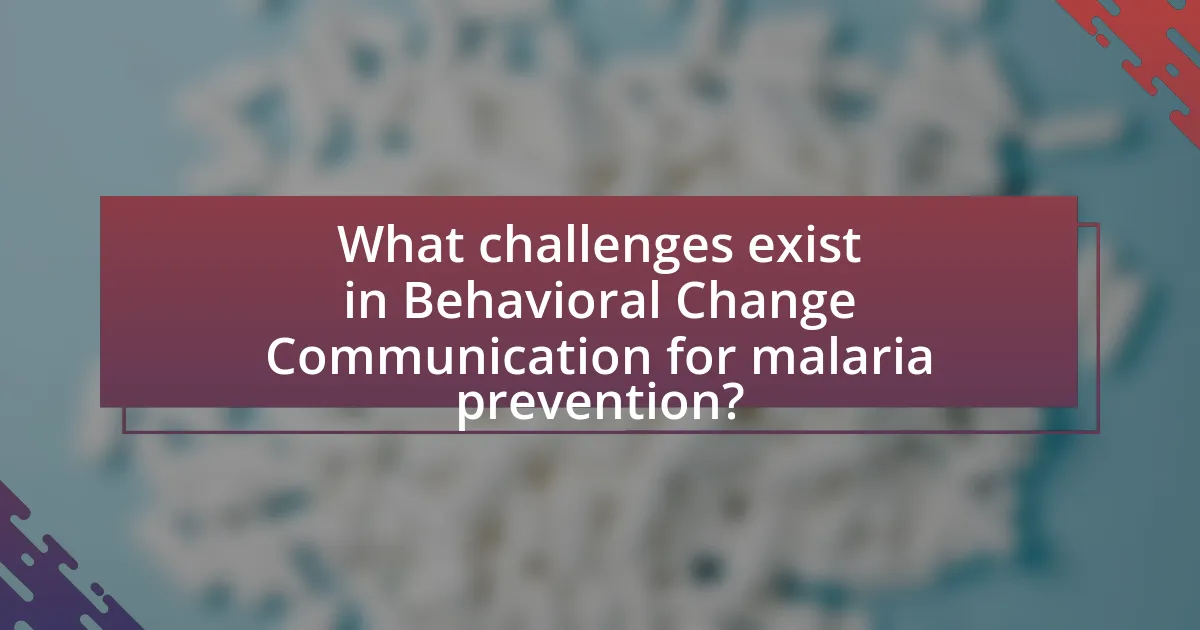
What challenges exist in Behavioral Change Communication for malaria prevention?
Challenges in Behavioral Change Communication for malaria prevention include cultural beliefs, misinformation, and limited access to resources. Cultural beliefs can hinder the acceptance of preventive measures, as individuals may prioritize traditional practices over scientifically proven methods. Misinformation, often spread through social networks or media, can lead to skepticism about malaria prevention strategies, such as the use of insecticide-treated nets or indoor spraying. Additionally, limited access to educational resources and healthcare services can impede effective communication, making it difficult for communities to receive accurate information and support for behavioral changes. These factors collectively undermine efforts to promote safe practices against malaria.
What barriers hinder effective communication in malaria-endemic regions?
Barriers that hinder effective communication in malaria-endemic regions include language differences, cultural beliefs, and limited access to communication channels. Language differences can create misunderstandings between health workers and communities, as many local dialects may not be represented in health messaging. Cultural beliefs may lead to skepticism about malaria prevention methods, as traditional practices often conflict with modern health advice. Limited access to communication channels, such as radio, internet, or mobile phones, restricts the dissemination of crucial information about malaria prevention and treatment. These barriers collectively impede the effectiveness of behavioral change communication strategies aimed at encouraging safe practices against malaria.
How can misinformation about malaria be addressed through communication?
Misinformation about malaria can be addressed through targeted communication strategies that emphasize accurate information dissemination. Effective communication can involve the use of community engagement, educational campaigns, and the dissemination of clear, evidence-based messages through various media channels. For instance, the World Health Organization recommends using local languages and culturally relevant materials to enhance understanding and retention of information about malaria prevention and treatment. Research indicates that community-based interventions, such as workshops and discussions led by trusted local figures, significantly improve knowledge and attitudes towards malaria, thereby reducing the spread of misinformation.
What are the implications of cultural beliefs on malaria prevention messaging?
Cultural beliefs significantly influence malaria prevention messaging by shaping perceptions of risk and acceptable behaviors. For instance, in some communities, traditional beliefs may prioritize herbal remedies over scientifically proven methods like insecticide-treated nets or antimalarial medications. This can lead to resistance against adopting effective prevention strategies, as seen in studies where cultural practices overshadowed health recommendations, resulting in higher malaria incidence rates. Additionally, cultural narratives may frame malaria as a spiritual issue rather than a medical one, complicating public health efforts to promote evidence-based interventions. Understanding these cultural contexts is crucial for tailoring effective communication strategies that resonate with local beliefs and practices, thereby enhancing the overall impact of malaria prevention initiatives.
How can technology be leveraged to improve Behavioral Change Communication?
Technology can be leveraged to improve Behavioral Change Communication by utilizing mobile applications, social media platforms, and data analytics to disseminate information and engage communities effectively. Mobile applications can provide real-time updates and educational content about malaria prevention, while social media platforms can facilitate community discussions and share success stories, enhancing peer influence. Data analytics can identify target demographics and tailor messages to specific audiences, increasing the relevance and impact of communication efforts. For instance, a study published in the Journal of Medical Internet Research found that mobile health interventions significantly improved knowledge and preventive behaviors related to malaria among users.
What role do mobile health applications play in malaria education?
Mobile health applications play a crucial role in malaria education by providing accessible information and resources to users. These applications facilitate awareness about malaria prevention, symptoms, and treatment options, thereby empowering individuals to take proactive measures against the disease. For instance, a study published in the Journal of Medical Internet Research found that mobile health interventions significantly improved knowledge about malaria among users, leading to increased adoption of preventive behaviors. By leveraging features such as reminders for medication, educational content, and community support, mobile health applications enhance the effectiveness of behavioral change communication strategies aimed at reducing malaria transmission.
How can social media campaigns enhance awareness and behavior change?
Social media campaigns can enhance awareness and behavior change by effectively disseminating information and engaging users through interactive content. These campaigns utilize targeted messaging to reach specific demographics, increasing the likelihood of message retention and action. For instance, a study published in the Journal of Medical Internet Research found that social media interventions significantly improved knowledge and preventive behaviors related to health issues, including malaria. By leveraging visual storytelling, user-generated content, and community engagement, social media campaigns can foster a sense of collective responsibility and motivate individuals to adopt safer practices against malaria.
What are practical tips for implementing effective Behavioral Change Communication?
Practical tips for implementing effective Behavioral Change Communication include understanding the target audience, using clear and relatable messaging, and employing multiple communication channels. Understanding the target audience involves conducting research to identify their beliefs, values, and barriers to change, which allows for tailored messaging that resonates with them. Clear and relatable messaging ensures that the information is easily understood and relevant, increasing the likelihood of behavior adoption. Employing multiple communication channels, such as community meetings, social media, and printed materials, maximizes reach and reinforces the message through various formats. These strategies are supported by studies indicating that tailored communication significantly improves engagement and behavior change outcomes in health interventions, particularly in malaria prevention efforts.
How can feedback mechanisms improve communication strategies?
Feedback mechanisms can significantly enhance communication strategies by providing real-time insights into audience perceptions and behaviors. These mechanisms allow organizations to gather data on the effectiveness of their messaging, enabling them to adjust strategies based on audience responses. For instance, in the context of malaria prevention, feedback from community members can reveal misconceptions about transmission and prevention methods, allowing health communicators to tailor their messages more effectively. Research indicates that incorporating feedback loops can lead to a 30% increase in message retention and understanding, as evidenced by studies conducted in public health campaigns. This iterative process ensures that communication remains relevant and impactful, ultimately fostering better health outcomes.
What are the key indicators of success in Behavioral Change Communication for malaria prevention?
Key indicators of success in Behavioral Change Communication (BCC) for malaria prevention include increased knowledge about malaria transmission and prevention methods, improved attitudes towards preventive measures, and higher adoption rates of protective behaviors such as the use of insecticide-treated nets (ITNs) and indoor residual spraying (IRS). Research shows that effective BCC campaigns can lead to a significant rise in ITN usage, with studies indicating that communities exposed to targeted communication strategies saw usage rates increase by over 50%. Additionally, monitoring changes in community engagement and participation in malaria prevention activities serves as a vital indicator of BCC effectiveness.


